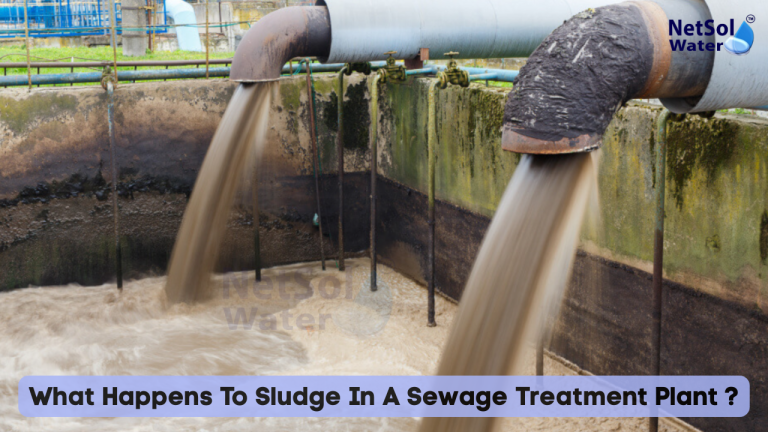
When it comes to building systems for managing sludge in a sewage treatment plants, companies like Commercial RO Plant set the standard. Solid wastes from raw water as well as wastewater are combined as sludge in a sewage treatment plant. It is actually formed when organic substances as a waste are broken down by various bacteria. Sludge management saves the environment & reduces health hazards. Strong sludge handling solutions have been developed by Commercial RO Plant for numerous facilities. Operators can safely & easily treat wastewater thanks to these solutions. Costs & waste volume are also decreased by efficient management. In this blog we discuss what happens to sludge in a sewage treatment plant.
We will gradually go across what eventually occurs to the sludge in a sewage treatment plant while simultaneously outlining the various phases that sludge pass across starting from collection to disposal or final utilization.
Thickening Process of Sludge
Volume begins decreasing with the accumulation of the thick sludge. By thickening, the sludge becomes denser & advances to the next stage more quickly. Let’s examine some important sludge thickening techniques.
Process of Gravity Thickening
Gravity thickening separates solids from liquids through the utilization of space along with time. A huge tank contains the muck. Solid wastes flow down to the bottom due to the action of gravity. The transparent liquid remains on top & proceeds to additional treatment. At the bottom, a thick layer of settled muck is formed. The liquid levels above are then removed by operators. This processing step significantly lowers down the water-content & cut down the strain on subsequent stages.
Thickening Process of Float Substances
Tiny air bubbles are injected into the sludge by employing process of flotation thickening. Solids are lifted to the surface by these bubbles. It is simple to skim the frothy layer that the solid produces. At levels below, the leftover liquid drains away. Compared to gravity thickening, this technique operates more quickly. It manages streams of thinner sludge as well. When plants require quick processing or a small footprint, they opt for flotation.
Digestion of Sludge
Biogas is a byproduct is generated during sludge digestion from decomposing organic material. Sludge becomes more stable after this stage. Let’s check up few of the diverse sludge digestion methods.
Anaerobic Digestion (Without Air)
Anaerobic digestion occurs in the absence of oxygen. Organic debris is broken down by microbes in a confined tank. Both Carbon dioxide as well as methane is simultaneously released during this process. Motor-Turbines can simply be powered by methane gas to generate electricity. The digester is also heated by the gas. The ideal pace of microbial activity is maintained by this heat. The bulk of sludge can be reduced by almost half through anaerobic digestion.
Sludge Processing through Aerobic digestion
The microorganisms are supported by oxygen through Aerobic digestion. In huge storage or operational tanks, the sludge interacts with air. The organic stuff is consumed by microbes in order to proliferate & flourish. They generate water & carbon dioxide. Energy is needed for this procedure in order to force airflow through the sludge for further digestion. When STP plants want to avoid handling biogas while maintaining access to inexpensive power, they employ this technique.
Dewatering of Sludge Wastes
After digestion, dewatering process further reduces the water content in the sludge. Sludge is prepared for recycling or disposal in this process. Let’s take few popular dewatering methods.
Belt Filter Press
Sludge Wastes are squeezed across two moving compressing belts in a belt filter press. Water is forced out by rollers. Through braided belts, the liquid flows away. There is fewer fluids by weight in the final solid cake produced. To maximize dryness, operators can modify the belt’s speed & pressure.
Centrifuge
A centrifuge separates particulates from water by spinning quickly. A revolving drum is filled with the sludge. The heavier solids are separated from the lighter liquids by high speed. An outlet allows the liquid to leave. The firm cake gathers & is gathered at the drum wall. Small to medium in size STP plants that require quick through-put do well with centrifuges.
Sludge Recycling & the Disposal Process
Sludge’s ultimate course is determined by its properties & regional laws. Sludge may end up in a landfill or find new life. Let’s examine various choices for disposal & repurposing.
Application of Land
Treated Waste from sludge can be provided to the soil. It enriches farmland with nutrients as well as organic matter. Phosphorus & nitrogen are necessary for plant growth. Strong rules guarantee that sludge satisfies safety requirements. Waste is transformed into a resource via this method.
Thermal Heating Process of Sludge
Sludge is heated to extreme temperatures in a kiln or incinerator through thermal treatment. Pathogens are destroyed and volume is decreased by the heat. You can use the ash as building material. Combustive power can be put through into the grid to take the process further. This process works with challenging sludge that doesn’t respond to conventional methods.
Conclusion
Every stage of managing sludge in a sewage treatment plant directly benefits the enterprises from the experience that company like Commercial RO plant delivers. So when you talk about what happens to sludge in a Sewage Treatment Plant above blog we mention all the factors about sludge in a sewage treatment plant. It builds & constructs every apparatus including thickening, digesting, dewatering, & disposal systems. Our products enable factories to run more safely while maintaining at lower costs. Contact us right now to find out how Commercial RO Plant will enhance your sludge handling business in a sewage treatment plant.
